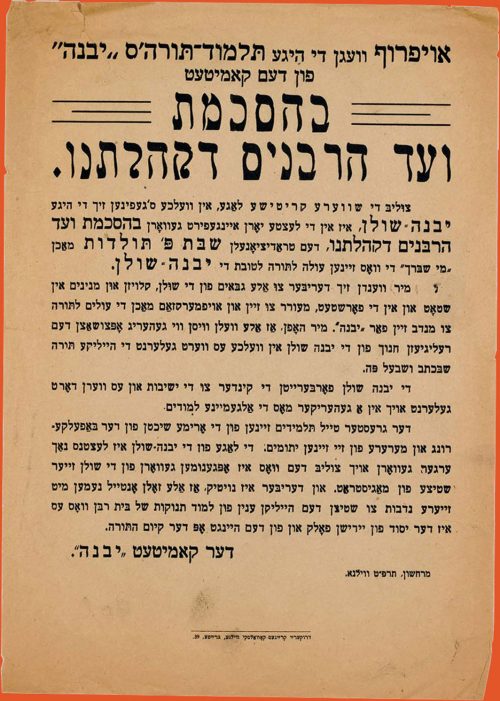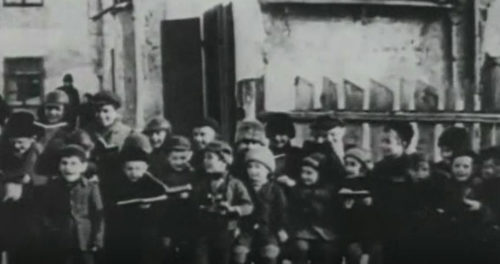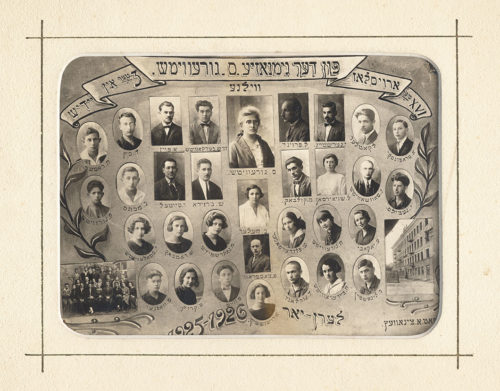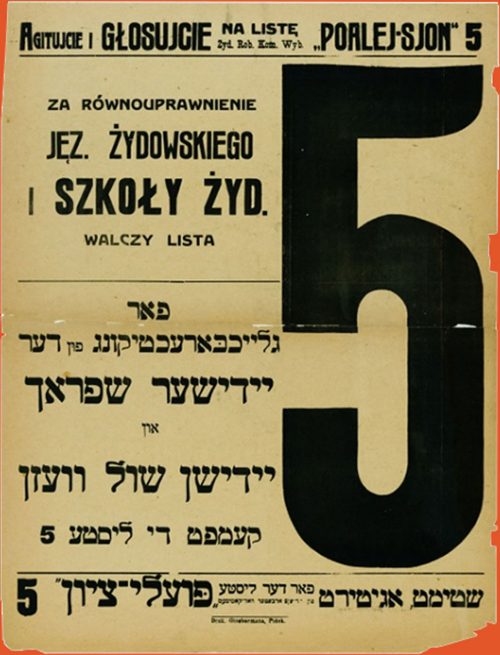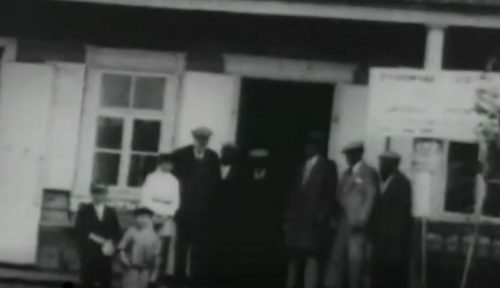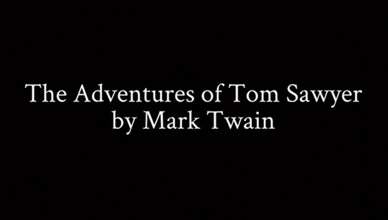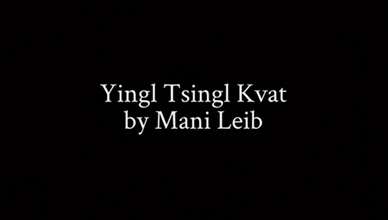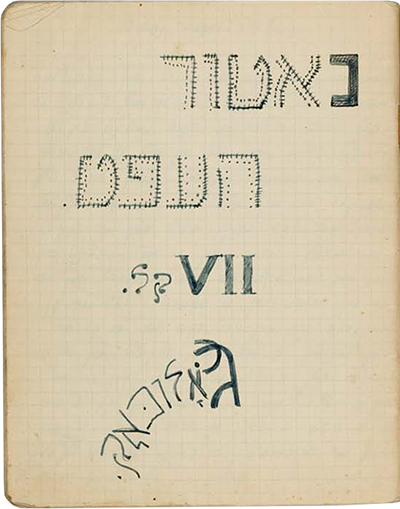Choose your
(school) adventure
In the 1930s, Jewish children in Poland had many choices when it came to their education. Here you will learn a little bit more about the different schools they could attend. You will also go to school with Beba Epstein. But first let’s head over to Itzkowitz’ Bookstore with Beba’s grandfather, Abba Senitski, to get your books!
Nazis come to power in Germany



The Sholem Aleichem School was named after the renowned Yiddish writer. It was a coed non-religious Yiddish-language school in Vilna. This school was part of the Tsentraler bildungs komitet (TsBK), the Central Education Committee. TsBK was the Vilna branch of the TSYSHO school system, which was supported by socialist political parties. The language of instruction in the school was Yiddish. Students also learned Polish and Polish history, and had the option of learning German, Latin, and French as they got older.
This notebook shows three essays from the sixth-grade class of the school. On June 19, 1940, the students from this class were asked to write essays on the topic of “How I See Myself A Year From Now.” Several of these essays reflect the uncertainty of life for Jews in Vilna in 1940, especially since three days before Soviet troops marched into Lithuania.
Digitization of this artifact has been made possible by the Edward Blank YIVO Vilna Online Collections project.
Brayne Gelfer writes that what she really wants is to continue with her education in gymnasium (high school). Her dream is to become an actress. However, she is 90% certain that, as a daughter of a poor family, she is headed for an apprenticeship as a seamstress or in a different trade.
Digitization of this artifact has been made possible by the Edward Blank YIVO Vilna Online Collections project.
Dobe Kluger writes that because the world is so turbulent, she can't project a year into the future. But she hopes she does not have to go through what children in Warsaw had to endure. Warsaw fell under German occupation in the Fall of 1939. If there is peace in a year, she expects to go on with her studies, but in what language she doesn't know. Whatever happens she is sure that "the sun will continue to shine for us children."
Digitization of this artifact has been made possible by the Edward Blank YIVO Vilna Online Collections project.
Golde Aronson writes about how she wants to study nursing. But it depends on many things, including her financial circumstances and whether the world will still be at war.
Digitization of this artifact has been made possible by the Edward Blank YIVO Vilna Online Collections project.





The D. Kuperstein School was a girls’ school that existed in Vilna until the mid-1930s. Back when the school was founded in 1912, boys still typically attended kheyders, the religious elementary schools. A religious education was not emphasized for girls, so they were freer to concentrate on secular studies. As a result, they would often end up more educated in non-religious matters than their brothers were. The D. Kuperstein School was one example of the kind of school for girls that was becoming more available by the beginning of the 1900s.
In the 1930s D. Kuperstein was part of the Tsentraler bildungs komitet (TsBK), the Central Education Committee. TsBK was the Vilna branch of the TSYSHO school system, which was supported by socialist political parties. The students of the D. Kuperstein School were educated in Yiddish. They also learned Polish and Polish history, and could additionally learn German, Latin, and French as they got older.
Digitization of this artifact has been made possible by the Edward Blank YIVO Vilna Online Collections project.
Two pages from a Polish History notebook written by a student of the D. Kuperstein school in 1927. This section contains a description of Tatars, a Turkic-speaking Muslim minority that began settling in Poland during the 1300s. It also includes genealogy and historical information about Polish kings of the 1200s. Polish noblemen Władysław I the Elbow-high and Wenceslaus III of Bohemia appear on the left page, and Bolesław V the Chaste appears on the right page.
Digitization of this artifact has been made possible by the Edward Blank YIVO Vilna Online Collections project.
Two pages from a natural science notebook including descriptions and examples of several botanical families of vegetables, including the nightshade family. These pages were drawn and written by a student of the D. Kuperstein School in 1928.
Digitization of this artifact has been made possible by the Edward Blank YIVO Vilna Online Collections project.
Two pages from a natural science notebook including a description and illustrations of flowers, possibly peonies, drawn and written by a student of the D. Kuperstein School in 1928.
Digitization of this artifact has been made possible by the Edward Blank YIVO Vilna Online Collections project.
Two pages from a natural science notebook that include a description of vertebrates on the right and an illustration of a lion’s skeleton on the left. Drawn and written by a student of the D. Kuperstein School in 1928.
Digitization of this artifact has been made possible by the Edward Blank YIVO Vilna Online Collections project.
An excerpt from a notebook with Yiddish poems about Autumn written by a student of the D. Kuperstein School in Vilna.
Digitization of this artifact has been made possible by the Edward Blank YIVO Vilna Online Collections project.




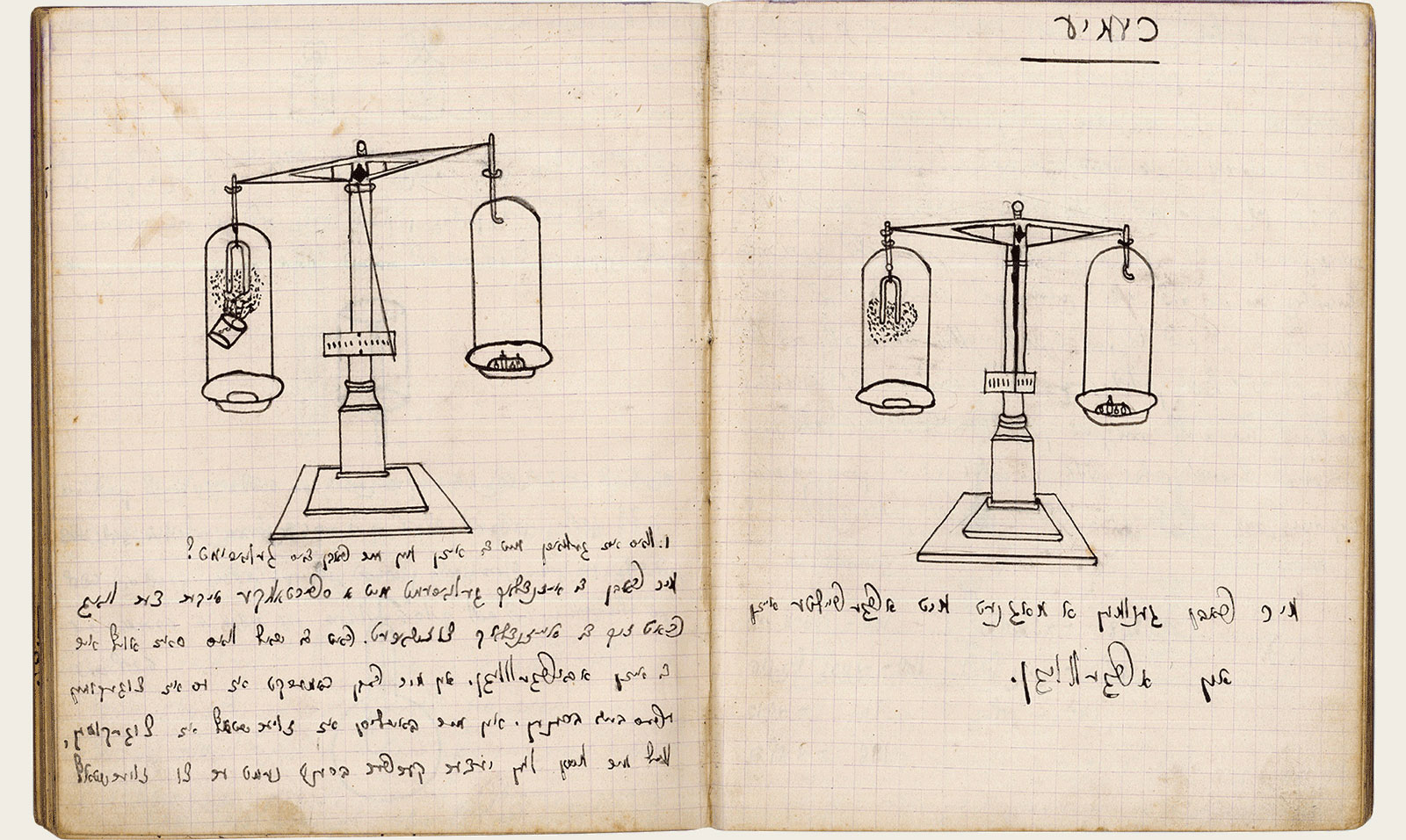
The Kobrin folkshul taught topics such as natural history, science, and ancient history, with Yiddish as the main language of instruction. These excepts are from the student Mikhlye Kozak, a girl who attended this school in the mid- to-late 1920’s. Topics covered in Mikhlye’s notebooks include natural science, chemistry, and anatomy.
These pages of Mikhlye’s notebook contain a discussion about bones and skeletons with a detailed drawing of a human skull, including the labeling of 11 specific parts. There also is a similar drawing and description of a newborn’s skull.
These pages of Mikhlye’s notebook contain cut-outs and descriptions of different animals, including seals and polar bears.
These pages are a part of Mikhlye’s science notebook. They contain illustrations and descriptions of a chemistry lab setup with Erlenmeyer flasks and Bunsen burners.
These pages are a part of Mikhlye’s ancient history notebook, describing the European Nations from 4,000 years ago. The left page describes the tools used in the Stone Age, from primitive weapons to tools for building to everyday items made from sharpened stone, animal bones, clay, and wood. The top of the right page describes houses of the time. One room of the home was for animals, and one room was for sleeping and cooking. The bottom of the page describes how people of the time gathered food. People went hunting, domesticated animals, gathered fruits and berries, and harvested grains such as wheat, barley, and millet.
These pages are a part of Mikhlye’s science notebook. They contain a description and illustrations of a chemistry experiment that involves the balance between differently-heated contents.

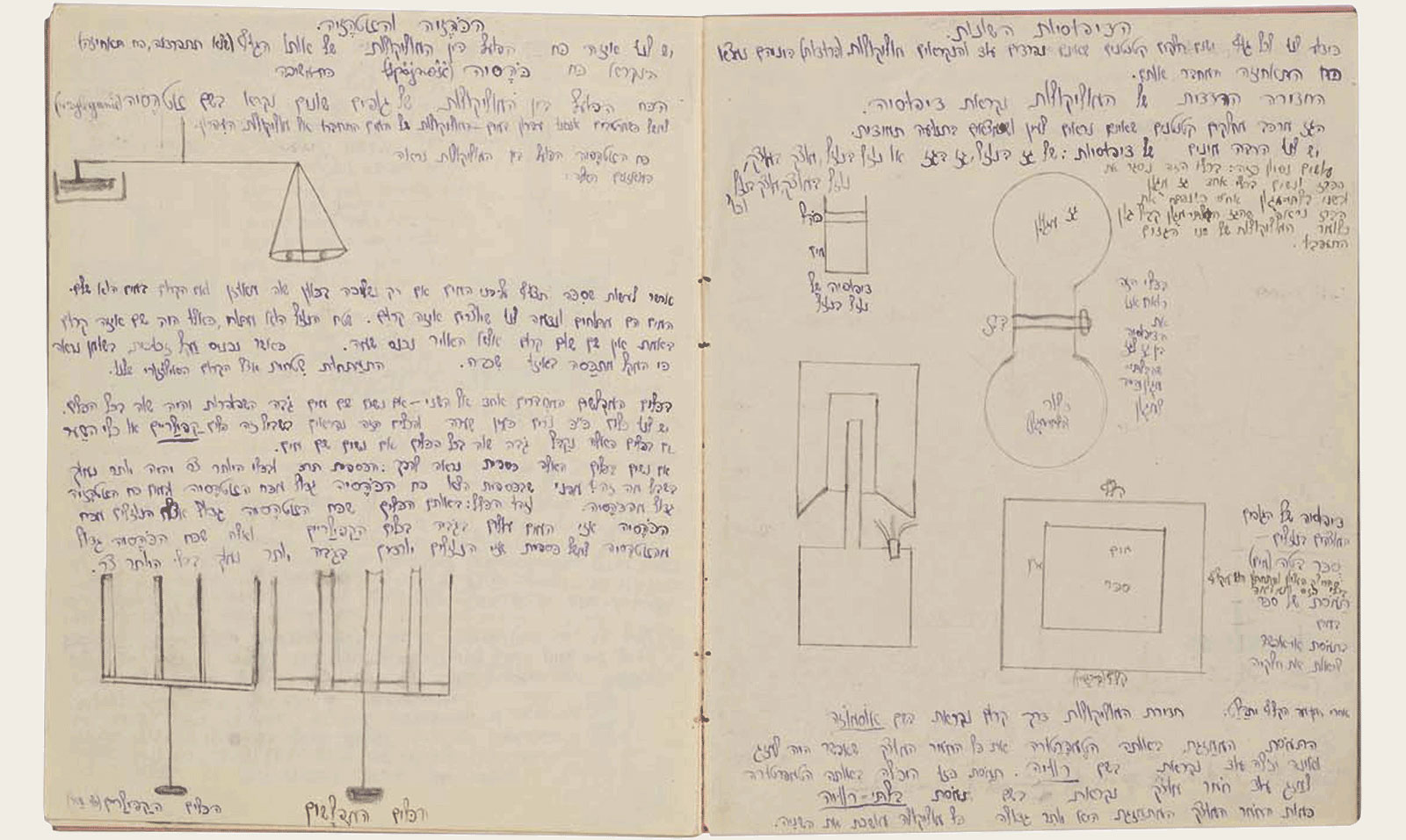


Tarbut was a network of coed secular Zionist schools that operated in Poland during the interwar period. The language of instruction in these schools was Hebrew. That was in line with the Zionist movement’s support of Hebrew as the language of Jewish renewal and the return of Jews to their ancestral homeland in what is now known as Israel. Tarbut schools taught Jewish and general studies, including the humanities and the sciences. Students also learned Polish and Polish history, which was required by the independent nation of Poland. They also learned Latin and German.
Digitization of this artifact has been made possible by the Edward Blank YIVO Vilna Online Collections project.
Mathematical calculations from a physics notebook. The student measures with and diagrams instruments such as a metronome, a caliper, and a micrometer screw. The student also references a parasang. That is an ancient unit of length, which is calculated by the student as "seven and a half kilometers."
Digitization of this artifact has been made possible by the Edward Blank YIVO Vilna Online Collections project.
The student describes the properties of molecules and the forces of attraction that bring them together. Both the processes of osmosis and saturation are mentioned. On the left page, the student describes an experiment used to demonstrate these molecular properties: "… for example, when we wet a pencil in water, the molecules of the water latch on to the molecules of the pencil."
Digitization of this artifact has been made possible by the Edward Blank YIVO Vilna Online Collections project.
The student describes a stage of the experiment involving the expansion of molecules as they are heated: "the gas is comprised of the molecules located inside… the gases expand when the temperature is high… the gas expands outside [of the container] not just because the temperature is high, but also because the volume gets larger."
Digitization of this artifact has been made possible by the Edward Blank YIVO Vilna Online Collections project.
Continuation of experiments
Digitization of this artifact has been made possible by the Edward Blank YIVO Vilna Online Collections project.
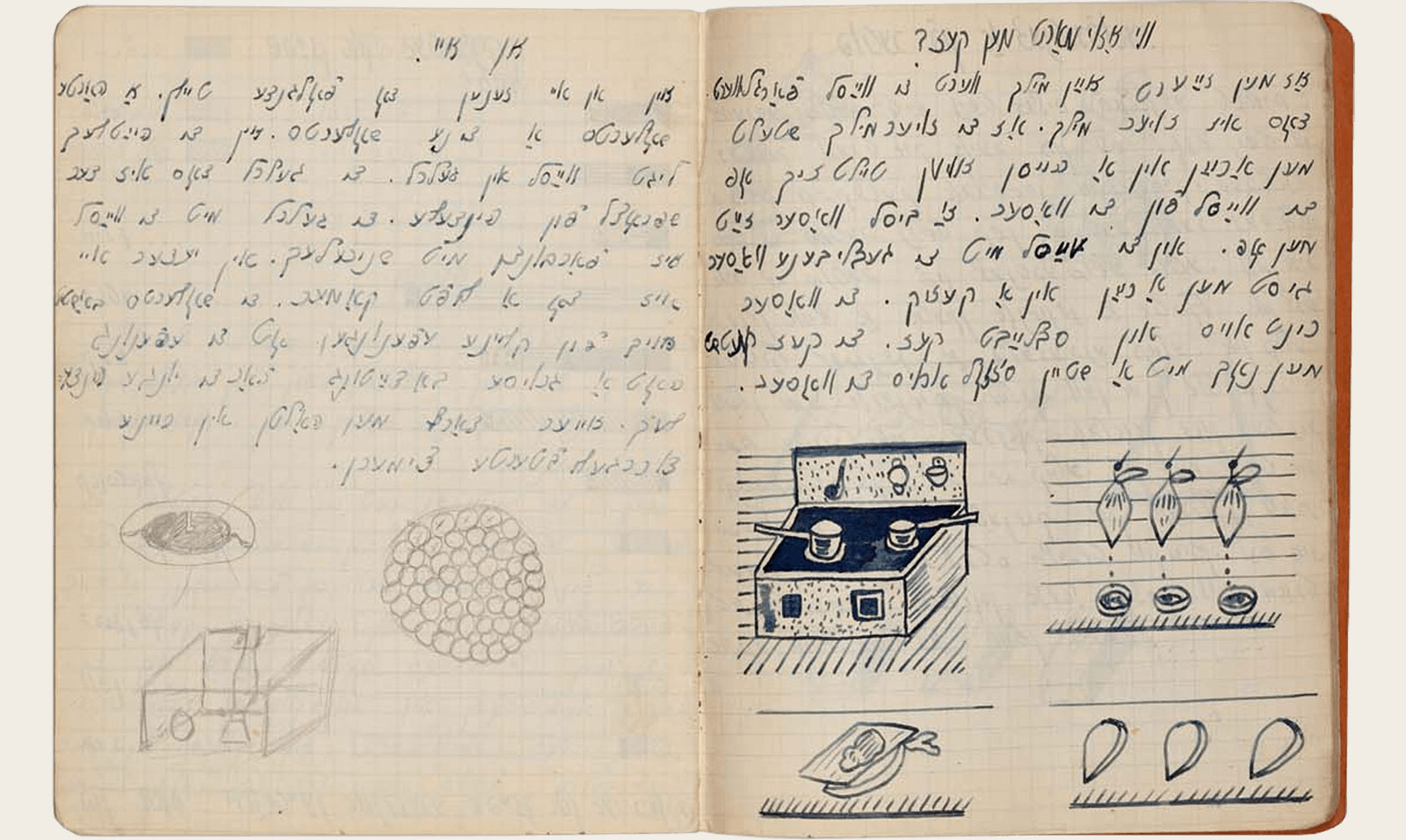



This notebook is representative of a school in the Tsentrale yidishe shul organizatsye (TSYSHO) school system, which was the Central Yiddish School Organization. The school was located outside of Vilna in Oszmiana, Poland. It belonged to a student named R. Golubok in 1937. The TSYSHO school system was, in general, coed, and supported by the Bund. The Bund was a socialist political party that maintained Yiddish culture and language in the belief that the future of the Jewish people would best unfold in the diaspora, in the countries in which the Jews lived. Before the war, the Bund was hostile to the Zionist movement. The Zionists supported the use of Hebrew as the language of Jewish renewal and the return of Jews to their ancestral homeland in what is now known as Israel.
The main language of instruction in the school was Yiddish, but students also studied Polish and Polish history. They could additionally learn German, Latin, and French as they got older. The topics included in the notebook range from anatomy to home economics lessons on cooking.
Digitization of this artifact has been made possible by the Edward Blank YIVO Vilna Online Collections project.
The left page of Golubok’s notebook includes a detailed description of a chicken. The right page is titled “How to Make Cheese.” This provides instructions and illustrations of the kitchen processes used in making cheese.
Digitization of this artifact has been made possible by the Edward Blank YIVO Vilna Online Collections project.
This page marks the start of a new section of Golubok’s notebook. The section’s topic is about anatomy.
Digitization of this artifact has been made possible by the Edward Blank YIVO Vilna Online Collections project.
This page contains the illustration of a skeleton and its corresponding bones.
Digitization of this artifact has been made possible by the Edward Blank YIVO Vilna Online Collections project.
The left page of Golubok’s notebook contains a description of breathing mechanisms in living creatures, such as windpipes, lungs, etc. On the right page, there is a detailed illustration of skin layers.
Digitization of this artifact has been made possible by the Edward Blank YIVO Vilna Online Collections project.
Beba Epstein
Sofia Gurevitch School,
Vilna, Poland
5th year, 1933-34
The Sofia Gurevitch School was a secular Yiddish school founded in Vilna in 1906 by S.M. Gurevitch and P.P. Antokolski. From 1906 to 1915, it functioned as a Jewish high school with Russian as the language of instruction. During that time period Vilna was part of the Russian Empire, which imposed restrictions on Yiddish language schools. Later, when Vilna was part of Poland, the school adopted a Yiddish secular approach and added an elementary school. It became part of the Tsentraler bildungs komitet (TsBK), the Central Education Committee. TsBK was the Vilna branch of the TSYSHO school system, which was supported by socialist political parties. The school was known for its high educational standards and progressive methods. The high school operated until 1933. At that time, it was closed along with several other high schools where Yiddish was the language of instruction. The elementary school remained open.
Please note this is not Beba’s actual notebook, but a compilation of activities (some contemporary) based on what we know was taught at the Sofia Gurevitch School. Beba was a student there while in elementary school. This is the cover of Beba's autobiography. Digitization of this artifact has been made possible by the Edward Blank YIVO Vilna Online Collections project.
When Beba was a student at Sofia Gurevitch, the language of instruction was Yiddish. But students learned Polish as well because Polish and Polish history were mandatory subjects in Poland at the time.
When Beba was a student at Sofia Gurevitch, the language of instruction was Yiddish. But students learned Polish as well because Polish and Polish history were mandatory subjects in Poland at the time.
Students at the Sofia Gurevitch school studied math and geometry. This drawing, from the collection of Sara Karcewicz, is contemporaneous to Beba's time at the Sofia Gurevitch, and illustrates a possible subject of study.
This spread shows sample lessons of Math and Biology from the Sofia Gurevitch school archives. The drawing was taken from a notebook whose digitization has been made possible by the Edward Blank YIVO Vilna Online Collections project.
Students had music lessons as well. Beba was especially fond of classical music. Chopin was one of her favorite composers.
Students had music lessons as well. Beba was especially fond of classical music. Chopin was one of her favorite composers.
Some of Beba’s favorite moments at Sofia Gurevitch were book readings. Her teachers would read booksto them. Titles could range from books written originally in Yiddish to famous titles from around the world translated into Yiddish.
Students at Sofia Gurevitch studied politics as well. This spread displays a collage of a newspaper clipping, an excerpt of a document, and a flyer that show the political climate in 1933.
Not all Jewish children were involved in politics. But if they were it was not uncommon for them to have political views that differed from their families. There was a growing political consciousness among Jewish youth at the time. Beba's family was very involved with the Bund. The Jewish socialist party had an influence on her. Her little brother Motejoined the pioneers instead. The pioneers was a Communist youth group. Communism and Socialism were two competing philosophies among the Jewish left.
News credit: Jewish Telegraphic Agency - Daily News Bulletin, June 25, 1933 - story may not be reproduced without JTA's permission.



